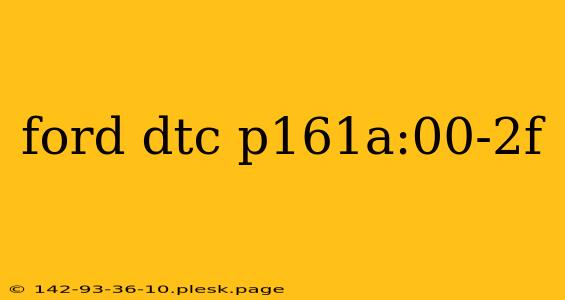The Ford diagnostic trouble code (DTC) P161A:00-2F points to a problem within the vehicle's anti-theft system. This isn't a code you want to ignore, as it can directly impact your ability to start and operate your Ford vehicle. This comprehensive guide will break down what P161A:00-2F means, potential causes, and effective troubleshooting steps.
Understanding DTC P161A:00-2F
The code itself, P161A:00-2F, indicates a malfunction within the Passive Anti-Theft System (PATS). The PATS system is designed to prevent unauthorized operation of your vehicle. It uses a transponder key, embedded within your car key, to communicate with the vehicle's control module. If this communication fails, you'll likely encounter starting issues. The "00-2F" portion of the code provides more specific information about the nature of the communication failure, potentially pointing towards a specific component or circuit malfunction within the PATS system.
Common Causes of P161A:00-2F
Several factors could trigger this frustrating DTC. Here are some of the most common culprits:
1. Faulty Ignition System Components:
- Worn or Damaged Ignition Switch: The ignition switch is crucial for the PATS system's proper operation. Wear and tear, or even physical damage, can disrupt communication.
- Problematic Ignition Coil: While not directly related to the PATS system, a faulty ignition coil can lead to misfires and ultimately trigger the P161A code as a secondary effect due to the system's self-diagnostic routines.
2. Issues with the Transponder Key:
- Damaged or Weak Battery in Key Fob: If your key fob's battery is weak or dead, it may fail to transmit the necessary signal, resulting in the error code.
- Faulty Transponder Key: The transponder chip within your key itself could be damaged or malfunctioning.
- Incorrect Key Programming: Improper programming of the PATS system can lead to conflicts.
3. Problems with the Vehicle's Wiring and Electrical System:
- Damaged Wiring: Damaged or corroded wires within the PATS system's circuits can prevent proper signal transmission. Check for any broken or frayed wires around the ignition switch and related components.
- Faulty BCM (Body Control Module): The BCM plays a critical role in communication within the vehicle, including the PATS system. A malfunctioning BCM can trigger various DTCs, including P161A.
Troubleshooting Steps for P161A:00-2F
Before attempting any repairs, it’s crucial to have your vehicle properly diagnosed. This involves using an OBD-II scanner capable of reading Ford-specific codes. Generic scanners may not provide the detailed information needed to pinpoint the exact problem.
Here's a suggested troubleshooting process:
-
Check the Key Fob Battery: Replace the battery in your key fob. Often, a simple battery change resolves the issue.
-
Try a Spare Key: If you have a spare key, try using it. If the problem persists with both keys, the issue lies elsewhere within the vehicle's systems.
-
Inspect the Ignition Switch: Visually inspect the ignition switch for any signs of damage or wear. This can be challenging; consider seeking professional assistance for this step.
-
Check Wiring: Carefully examine the wiring harness connected to the ignition switch and other PATS components for any signs of damage, corrosion, or loose connections.
-
Professional Diagnosis: If the problem persists, a trip to a qualified Ford mechanic or auto-electrician is recommended. They possess the specialized tools and expertise to diagnose the issue effectively and perform any necessary repairs.
Prevention and Maintenance
While some issues are unavoidable, regular vehicle maintenance can help prevent many of the causes leading to DTC P161A:00-2F. This includes:
- Regular Battery Checks: Periodically check the battery in your key fob and replace it as needed.
- Careful Key Handling: Avoid dropping or damaging your car keys.
- Professional Inspections: Consider having your vehicle’s electrical system inspected during regular servicing.
By following these steps and seeking professional help when needed, you can effectively address the Ford DTC P161A:00-2F and get your vehicle back on the road safely and securely. Remember, always prioritize safety and seek professional assistance if unsure about any repair procedure.

